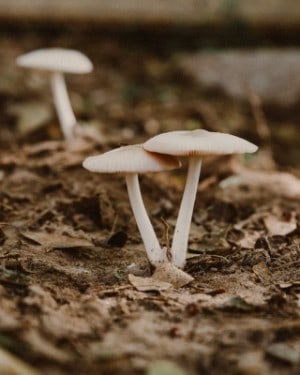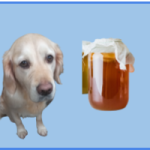
If you have just seen your dog eat a mushroom and then throw up, then you need to act fast.
I mean if you have just given your dog a bite of your mushroom pizza and then seen them vomit, your dog will probably be fine.
The mushroom didn’t agree with them but the body has sorted it out by throwing up.
However, if all this has happened whilst out on a walk, then things could be far more serious and you need to get in touch with your vet ASAP.
And that is the trouble when your dog eats a wild mushroom.
They might be eating a mushroom and then throwing up immediately afterwards or they might throw up hours after eating the mushroom.
Some dogs might eat a mushroom and not throw up at all.
But mushrooms are so poisonous and toxic that, regardless of what symptoms that your dog has, you need to phone your vet as quickly as possible.
Are mushrooms poisonous to dogs?
Did you know that there are over fourteen thousand different mushrooms?
A small percentage of these are poisonous- in the sense that if your dog ate them, they would become unwell for a few days, but they wouldn’t die.
Even fewer species of mushrooms are so poisonous that they are fatal.
It is hard to put an exact number of these mushrooms- although this website estimates it to be about thirty types of mushrooms that are fatal to humans.
The good news is that the mushrooms that most of us buy from our supermarkets aren’t poisonous to our dogs.
I mean, I think because of the texture it will ever be seen by your dog as appetising but a bite of mushroom pizza or a lick of a mushroom soup, won’t do them too much harm!
Are wild mushrooms dangerous to dogs?
But the real danger as far as mushrooms are concerned are the ones that your dog will come across on their walks or perhaps even when they are in the back garden.
It is here that those thirty or so fatal mushrooms species will be found.
Why do dogs eat mushrooms?
Little is known about why a dog might eat a mushroom whilst out on a walk.
Dogs are stimulated by the sounds and smells of the world around them whilst they are out and about.
And many mushrooms have a distinct smell to them.
For instance, one of the most toxic mushrooms (a death cap) has a strong smell a bit like cleaning fluid.
It sounds strange but that smell might be interesting to some dogs.
At other times, there may not be any logical reason why your dog eats a particular mushroom.
It is just that at that moment in time, they fancied exploring the world by eating something!
Much like they do when they eat grass.
What do toxic mushrooms look like?
Oh that is were as simple as offering you a visual guide to the 10 most poisonous mushrooms!
The trouble is that some of the most toxic mushrooms look remarkably similar to mushrooms that are perfectly safe for your dog to eat.
And so the best thing to do is to treat all mushrooms the same and to stop your dog from eating any wild mushroom at all.
What are the symptoms of mushroom poisoning in a dog?
There is a long list of symptoms of mushroom poisoning in dogs.
And the reason for this is that different mushrooms attack a dog’s body in different ways.
Poisonous mushrooms have one of four different types of toxins.
I will focus on just three of these; gastrointestinal, hepatotoxic and nephrotoxic
Gastrointestinal
These toxins affect a dog’s stomach and will cause sickness and diarrhea. Fortunately it is unlikely that mushrooms with these toxins will be fatal to your dog.
Hepatotoxic
These toxins target the liver and if eaten in sufficient quantities, eating mushrooms with these toxins will kill your dog because their liver will stop working.
Symptoms include lethargy and jaundice.
Nephrotoxic
Mushrooms that are nephrotoxic attack the kidneys and can easily be fatal. Symptoms include vomiting and diarrhea.
The most confusing things about these symptoms is that some won’t appear for hours, others appear within minutes and still other symptoms will appear and then disappear.
The only thing to do if you think that your dog has eaten a mushroom whilst out on a walk is to phone up your vet and book an emergency appointment.
Even if your dog seems outwardly fine there might be invisible and irreversible damage being done to your dog.
How might a vet treat mushroom poisoning in a dog?
Any case of mushroom poisoning will start with an outpatient appointment and many of them will result in the dog being hospitalised for further treatment.
Blood and urine samples will be taken and a vet might try and get a sample of the mushroom from the dog’s stomach.
Other treatments might include being fed activated charcoal, which will help to absorb the toxins or being given lots of fluids to help flush the toxins from the body.
What will a vet need from you?
Just like any trip to the vets, they need as much accurate information from you as possible.
They will want to know the approximate time that your dog ate the mushroom and when they started to vomit.
Is your dog displaying any other symptoms?
If you can, get a sample of the mushroom.
Fish it out of your dog’s vomit or get a sample from the place on the walk where your dog ate it.
If you can’t get a physical sample of the mushroom then a good quality photo could also help your vet.
How much toxic mushroom is enough to kill a dog?
This all depends on how big the dog is, the type of mushroom that they ate, how much or how quickly they vomited the mushroom and how quickly you get them to the vets.
But as I mentioned earlier, just because your dog doesn’t immediately display any symptoms, it doesn’t mean that they are OK.
The kidneys or liver could be beginning to fail and unless you act quickly, your dog’s health is at risk.
Closing Thoughts
If you have been out and about for a walk with your dog, only to see them eat a mushroom and throw up, then act now and phone your vet.
Quick action might be the difference between life and death for your dog.






